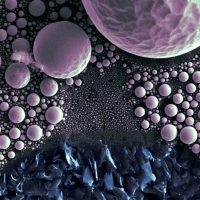Unprecedented polymer diverter trial
 How do you deal with thief zones where water is sweeping through the reservoir from injector to producer?
How do you deal with thief zones where water is sweeping through the reservoir from injector to producer?
One operator tried a new type of polymer to divert water in a water flooded reservoir. The polymer is named nanospheres. He hopes that the nanospheres will set up in water-frequented pathways. If successful, this forces injection water into unswept portions of the reservoir.
This polymer could be the answer to your water break through problem.
?subject=Help me get up to speed on ASP flooding&body=Help me get up to speed on ASP flooding%0D%0A%0D%0AMy Name:__________ %0D%0AMy Phone Number:__________ %0D%0A%0D%0A(Or call Proven Sales at 403-803-2500.)">Contact Proven for support. We have all the details from all the installations.
You can get his discussion of nanospheres from his regulatory application -- delivered to you within moments by clicking on the button below.
Buy these submission docs now Subscribers get them for freePolymer is expensive
Injecting polymer into a floods is much more expensive than just injecting water. Even if the polymer shuts off some water and encourages more oil production, the additional cost of injectant can seriously mar the flood economics.
Polymer or ASP?
Most polymer floods in Canada are now ASP floods. The staged ASP strategy amplifies recovery. But ASP is even more expensive than polymer floods.
The P in ASP stands for polymer. The polymer is expected to set up and plug areas in the reservoir where water has already swept. The polymer also increases the viscosity of the injectant to reduce fingering and increase recovery.
S is for Surfactant. Surfactant changes the wettability of the system which causes more oil to be mobile. Then the oil can be pushed by the polymer.
A is for Alkali. Alkali pretreats changing the acidity of the formation water so the surfactant can do its job. In the reservoir, the Alkali also creates a polymer soap -- a natural surfactant.
Get the real ASP story from applications
A, S and P chemical manufacturers all claim superior results. But the best way to be sure is to study results in others' fields.
If you can find a field that is under polymer flood, you can study the success (or failure) for yourself. You can look at the production results. You can determine how much the reserves increased. You can decide how much the water cut dropped.
Applications have a much more trustworthy story about the success and failure of ASP than any other source. Better than sales literature. Better than technical papers.
Every application is ground-truthed to an actual well location in UTM or Lat/Long. You can follow up your reading of an ASP application with an actual look back at the production history before, during and after the ASP injection.
Better than technical papers
Applications are a much better source of information than technical papers for two reasons. First, applications are adjudicated by a picky regulator rather than a peer reviewer. The regulator is interested in increasing reserves, not in exploring science.
Second, applications explore both the benefits and also the problems and difficulty with ASP. Technical papers usually only focus on one dimension of field or lab results.
?subject=I want a cheap and cheery one day trial of AppIntel to search for ASP schemes&body=Sign me up fro a one day AppIntel trial so I can to search for ASP schemes.%0D%0A%0D%0AMy Name:___%0D%0AMy Phone Number:____%0D%0A%0D%0APricing: www.appintel.info/short-term-search/%0D%0A%0D%0A(Or call AppIntel Sales at 403-803-2500.)">Contact us now for a one day trial.
Tags: Polymer, Flood
 Granger Low 20 Dec 2016
Granger Low 20 Dec 2016

Energy industry badly needs AI for growth
But chatbots are giving AI a bad name

Pacify the picky regulator
They want all the details

The paradigm shift your competition hopes you ignore
How will you keep up with a once-in-a-generation investment opportunity?

LLM more trendy than LNG?
Large Language Model for oil and gas

Too busy to use oil and gas AI?
Then you are too busy to add oil and gas production quickly

How do we train the millennial oil and gas knowledge worker?
How will they stay current? How will they add more oil and gas?

Prevent SAGD Breakthrough
And see his net pay maps

The shortcut that could end your career and your company
Don’t start or optimize secondary recovery without expert help

Oil and gas will not tolerate AI hallucinations
AI for the industry must be trustworthy




 Calgary, Alberta, Canada
Calgary, Alberta, Canada
 Share
Share